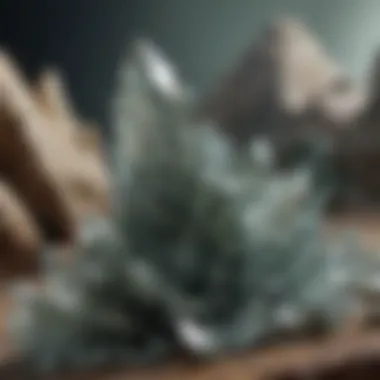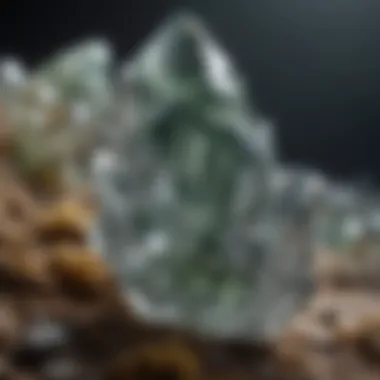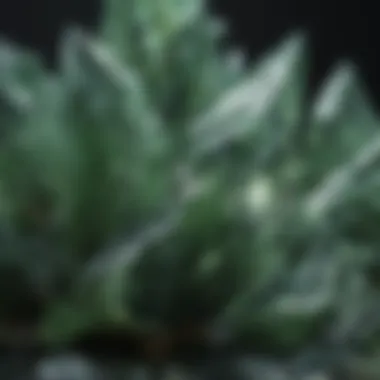Unveiling the Mystique of Chlorite Crystals: A Geological Exploration


Rock and Fossil Identification
Chlorite crystals, known for their mesmerizing green hues and intricate structures, are a fascinating subject within the realm of geology and mineralogy. When identifying these unique specimens, it is crucial to look for key characteristics such as their vibrant green color and foliated appearance. Tools such as magnifying glasses and UV lights can aid in the identification process by highlighting the characteristic properties of chlorite crystals.
Geological Insights
The formation process of chlorite crystals offers valuable insights into the geological processes that shape our planet. These crystals are typically found within metamorphic rocks, formed through the alteration of primary minerals such as biotite and amphibole. The presence of chlorite crystals can provide significant clues about the conditions under which these rocks underwent metamorphism, shedding light on the Earth's dynamic history and geological transformations.
Preservation and Display
Preserving chlorite crystals is essential to maintain their beauty and integrity over time. Techniques such as storing them in a dry, cool environment and avoiding exposure to direct sunlight can help prevent discoloration and damage. To showcase these exquisite specimens, consider creative display ideas such as placing them in shadow boxes or using LED lighting to enhance their natural radiance. Proper storage and display not only protect the crystals but also amplify their aesthetic allure.
Collecting Tips and Techniques
For rock and fossil collectors seeking to add chlorite crystals to their collection, it is vital to follow best practices to ensure a successful and enjoyable collecting experience. Prime collecting sites for chlorite crystals may include areas with metamorphic rock formations or regions known for their mineral diversity. When extracting specimens, use tools like chisels and brushes to safely remove crystals from surrounding rock matrix, taking care to preserve their structure and integrity.
Introduction to Chlorite Crystals
In the realm of geology and mineralogy, the topic of Chlorite Crystals holds significant importance. As we embark on this detailed exploration of Chlorite Crystals, it becomes evident that these specimens are not just any ordinary minerals. Their distinctive properties and formations make them a captivating subject for enthusiasts, researchers, and collectors alike. Understanding Chlorite Minerals is crucial to unraveling the mysteries behind their unique green hues and complex structures. By studying the Chemical Composition of Chlorite, we can delve into the elemental makeup that gives these crystals their distinct characteristics. Exploring the Physical Characteristics of Chlorite Crystals further enhances our appreciation for their beauty and geological significance.
Understanding Chlorite Minerals
Chemical Composition of Chlorite
When it comes to Chlorite Crystals, their Chemical Composition plays a pivotal role in defining their properties. Comprised primarily of silicate minerals, Chlorite's composition contributes to its characteristic green coloration. This specific aspect of Chlorite not only adds to its aesthetic appeal but also distinguishes it from other minerals in the geological landscape. The unique feature of Chlorite's Chemical Composition lies in its versatility, making it a popular choice for geological studies and collector's specimens.
Physical Characteristics of Chlorite Crystals
The Physical Characteristics of Chlorite Crystals also play a vital role in understanding their allure. From their distinctive green coloration to variations in luster, each aspect contributes to the overall appeal of these crystals. It is through studying these physical properties that we gain insight into their formation processes and geological significance. While Chlorite's Physical Characteristics offer a range of benefits in terms of identification and appreciation, they also come with certain considerations regarding their care and preservation.


Historical Significance
Chlorite Crystals have not only captured the fascination of modern enthusiasts but also held historical significance throughout the ages. Early Observations of Chlorite allowed ancient civilizations to appreciate the beauty and properties of these crystals. The cultural and spiritual connections forged through Chlorite Crystals offer a glimpse into the beliefs and practices of our ancestors. By delving into the historical aspects of Chlorite, we can better appreciate its enduring charm and relevance in the present day.
Formation Process
The Formation Process of Chlorite Crystals is a complex interplay of geological conditions and crystallization mechanisms. Understanding the Geological Conditions for Chlorite Formation sheds light on the environments where these crystals thrive. Meanwhile, exploring the Crystallization Mechanisms showcases the intricate processes that give rise to Chlorite's unique structures. By unraveling the mysteries of their formation, we gain a deeper appreciation for the natural forces that shape these captivating minerals.
Types of Chlorite Crystals
Within the vast world of Chlorite Crystals, a diverse array of types and classifications await discovery. Exploring the Varieties and Classifications of Chlorite offers insights into the wide range of specimens found in nature. Each type presents its own unique characteristics and appeal to collectors and researchers. Additionally, delving into the Notable Chlorite Crystal Structures provides a deeper understanding of the crystallographic patterns that make these specimens truly remarkable.
Properties and Characteristics
In the realm of chlorite crystals, understanding their properties and characteristics plays a pivotal role in unraveling the mysteries of these enigmatic geological specimens. The distinct properties exhibited by chlorite crystals not only distinguish them from other minerals but also offer valuable insights into their formation process and geological significance. From their unique coloration to their optical properties, each characteristic of chlorite crystals contributes to their allure and appeal to collectors and researchers alike.
Color and Luster
Distinctive Green Coloration
The distinctive green coloration of chlorite crystals is a defining feature that sets them apart in the world of minerals. This vibrant hue, ranging from deep emerald to earthy olive tones, not only adds to their aesthetic appeal but also serves as a key identifier for collectors and geologists. The green coloration of chlorite crystals is attributed to the presence of iron within their chemical composition, giving them a signature look that is instantly recognizable. This unique color not only makes chlorite crystals highly sought after in the mineral collecting community but also provides valuable clues about their origins and geological formation.
Variations in Luster
When it comes to luster, chlorite crystals exhibit a wide range of variations, from dull to vitreous, depending on their composition and environmental conditions during formation. These differing lusters add depth and complexity to the appearance of chlorite crystals, making each specimen unique and intriguing to collectors. The variations in luster also play a crucial role in identifying different chlorite varieties and understanding their geological history. By studying the luster of chlorite crystals, researchers can gain insights into the conditions under which these minerals were formed and the processes that shaped their crystalline structures.
Crystal Habit and Cleavage
Common Crystal Forms
The crystal habit of chlorite crystals encompasses a diverse range of forms, including tabular, platy, and prismatic shapes that contribute to their overall morphology. These common crystal forms not only showcase the internal structure of chlorite crystals but also provide valuable information about their growth patterns and environmental factors during crystallization. By examining the unique crystal habits of chlorite specimens, geologists and collectors can decipher the intricate processes that led to their formation and gain a deeper understanding of their geological significance.


Cleavage Patterns
Cleavage patterns in chlorite crystals reveal the planes along which these minerals break when subjected to external forces, offering insights into their internal structure and bonding arrangements. The cleavage of chlorite crystals is typically perfect in one direction, resulting in smooth surfaces that reflect light in distinctive patterns. Understanding the cleavage patterns of chlorite specimens is essential for identifying these minerals and distinguishing them from similar minerals with different cleavage properties. By studying cleavage patterns, researchers can classify chlorite crystals more accurately and trace their geological evolution with greater precision.
Optical Properties
Birefringence and Double Refraction
The optical properties of chlorite crystals, including birefringence and double refraction, play a significant role in their characterization and identification. Birefringence refers to the ability of chlorite crystals to split light into two distinct rays, each vibrating in a different direction, creating a visual effect known as double refraction. This optical phenomenon is a key feature of chlorite crystals that allows researchers to study their internal structures and mineral compositions with high precision. By analyzing birefringence and double refraction in chlorite specimens, geologists can glean valuable information about their geological origins and formation processes.
Pleochroism in Chlorite Crystals
Pleochroism, the property of exhibiting different colors when viewed from different angles, is another intriguing optical characteristic of chlorite crystals. This phenomenon adds a dynamic visual element to chlorite specimens, showcasing various hues depending on the orientation of light and crystal axes. Pleochroism not only enhances the aesthetic appeal of chlorite crystals but also aids in their identification and differentiation from similar minerals. By exploring the pleochroic effects in chlorite crystals, researchers can delve deeper into their optical properties and unravel the complex internal structures that give rise to this fascinating phenomenon.
Hardness and Density
Mohs Hardness Scale
Chlorite crystals are assigned a moderate hardness rating on the Mohs scale, ranging from 2 to 2.5, indicating their susceptibility to scratching and abrasion. This specific aspect of chlorite crystals' hardness provides crucial information about their physical durability and resistance to external forces. By understanding their position on the Mohs hardness scale, collectors and researchers can assess the wear resistance of chlorite specimens and make informed decisions regarding their handling and storage.
Specific Gravity Measurements
The specific gravity of chlorite crystals, typically ranging from 2.6 to 3.3, reflects their density and relative weight compared to an equal volume of water. This characteristic property allows geologists to distinguish chlorite crystals from other minerals based on their mass-to-volume ratio. Specific gravity measurements provide valuable data for identifying and classifying chlorite specimens according to their mineral compositions and crystalline structures. By considering specific gravity in conjunction with other properties, researchers can unravel the geological context of chlorite crystals and unveil the secrets hidden within their intricate formations.
Significance in Geology and Mineralogy
In the realm of geology and mineralogy, the significance of chlorite crystals lies in their unique properties and their crucial role as indicators of metamorphic processes. Chlorite in metamorphic environments serves as a vital tool for geologists to assess the metamorphic grade of rocks, providing invaluable insights into the geological history of a specific region. Understanding the presence and characteristics of chlorite crystals helps geologists interpret the intensity of metamorphism and the conditions under which rocks have been formed and altered over time.
Chlorite in Metamorphic Environments
- Indicator of Metamorphic Grade: Within metamorphic environments, chlorite crystals act as indicators of the degree of metamorphism a rock has undergone. The presence of chlorite and its specific characteristics, such as texture and color variations, can indicate the temperature and pressure conditions the rock has been subjected to during the metamorphic process. Geologists rely on the unique properties of chlorite to decipher the metamorphic history of rocks accurately, allowing them to construct detailed geological maps and understand the tectonic evolution of a region.
- Associations with Other Minerals: Chlorite crystals often exhibit close associations with various other minerals in metamorphic rocks. These mineral assemblages provide geologists with essential clues about the conditions in which these rocks have evolved. By studying the associations of chlorite with minerals like biotite, quartz, or garnet, researchers can unravel the complex dynamics of metamorphic processes and discern the sequential events that have shaped the rock formation. Understanding these associations enhances the overall comprehension of metamorphic processes and enriches geological interpretations.


Industrial Applications
- Utilization in Various Industries: Chlorite's versatile properties find applications in several industries, including agriculture, cosmetics, and ceramics. Its chemical composition and physical characteristics make it a popular choice for soil conditioning, skincare products, and components in ceramic production. The adsorptive capacity of chlorite enables it to effectively retain moisture in soil, improve soil structure, and promote plant growth, making it a valuable resource in agriculture.
- Technological Uses of Chlorite: The technological sector benefits from chlorite's ability to act as a source of magnesium and various other elements. Its presence in building materials, electrical insulators, and refractory products highlights its significance in modern technologies. Moreover, chlorite's thermal stability and electrical insulation properties make it an ideal component in high-temperature applications, contributing to the advancement of industrial processes and innovation.
Research and Discoveries
- Recent Studies on Chlorite Properties: Ongoing research on chlorite properties has revealed new insights into its structural composition, optical behavior, and responses to environmental factors. The exploration of chlorite's unique characteristics, such as its pleochroism and birefringence, enhances our understanding of its geological significance and potential applications in various fields. Recent studies have focused on uncovering the hidden properties of chlorite crystals, shedding light on their diverse functionalities and enhancing their value in scientific research.
- Emerging Trends in Chlorite Research: The emerging trends in chlorite research center around sustainable utilization and innovative applications of this mineral. Scientists and researchers are exploring eco-friendly methods to extract and process chlorite, aiming to reduce environmental impact and enhance its industrial potential. The growing interest in chlorite-based nanocomposites, sensor technologies, and green energy solutions signifies a shift towards utilizing chlorite crystals in cutting-edge research and development ventures, paving the way for future breakthroughs in material science and environmental technology.
Collecting and Preserving Chlorite Crystals
In this section, we delve into the crucial aspect of collecting and preserving chlorite crystals, which holds significant importance in understanding and appreciating these unique geological specimens. Collecting and preserving chlorite crystals not only allows enthusiasts to build their collections but also plays a vital role in preserving these delicate formations for future generations. This topic serves as a practical guide for rock and fossil collectors, highlighting the essential elements and considerations involved in ensuring the longevity and integrity of chlorite crystal specimens.
Field Collection Tips
Locating Chlorite-Rich Deposits
When it comes to collecting chlorite crystals, the first step is identifying locations abundant in these captivating specimens. Locating chlorite-rich deposits requires a keen eye for geological features that indicate the presence of chlorite-bearing rocks. The key characteristic of these deposits lies in their association with specific types of rock formations, such as schists and phyllites, known for harboring chlorite minerals. This targeted approach allows collectors to focus their efforts on areas where chlorite crystals are more likely to be found, increasing the efficiency of their search. While locating chlorite-rich deposits offers a promising source of specimens, challenges may arise in accessing remote or rugged terrains where these deposits are situated, requiring collectors to navigate challenging landscapes.
Tools for Safe Extraction
Once the chlorite crystals have been located, the next critical step is their safe extraction from the surrounding rock matrix. Utilizing appropriate tools for extraction is essential to ensure the integrity of the specimens and prevent damage during the collection process. Tools such as rock hammers, chisels, and brushes are commonly employed for carefully extracting chlorite crystals from their host rocks. The key characteristic of these tools lies in their ability to facilitate precise and controlled removal of specimens without causing fractures or breakage. Choosing the right tools based on the size and embeddedness of the crystals is crucial to a successful extraction process. While tools for safe extraction enhance the efficiency and effectiveness of collecting chlorite crystals, collectors must exercise caution to avoid accidents or injuries while working in rugged or unstable terrains.
The Allure of Chlorite Crystals
Chlorite crystals hold a distinct allure that captivates enthusiasts and researchers alike. In this article, we will unravel the enchanting world of chlorite crystals, exploring their unique properties, formation process, and significance in geology and mineralogy.
Aesthetic Appeal
Intriguing Visual Patterns: The mesmerizing visual patterns found in chlorite crystals are a testament to the wonders of nature's artistry. These intricate patterns, often resembling delicate ferns or leafy greens, add a layer of complexity and beauty to these crystals. Their striking designs not only make them visually appealing but also offer insights into the crystal's growth and formation processes. The allure of these visual patterns lies in their ability to spark curiosity and admiration among collectors and crystal enthusiasts.
Rare Color Variations: Chlorite crystals exhibit a wide range of rare color variations, from deep emerald greens to subtle earthy tones. The diversity in color adds value and intrigue to these specimens, making them highly sought after in the world of crystal collecting. The rare color variations not only make each chlorite crystal unique but also reflect the environmental factors and mineral compositions that influenced their formation. Understanding the significance of these rare color variations enhances the appreciation and allure of chlorite crystals for collectors and researchers.
Value and Rarity
Market Demand for Chlorite Specimens: The market demand for chlorite specimens has been steadily increasing due to their unique aesthetics and metaphysical properties. Collectors and holistic practitioners value chlorite crystals for their healing energies and grounding qualities, contributing to the rise in demand. The versatility of chlorite in jewelry-making and home decor further fuels this demand, making them a popular choice among crystal enthusiasts. Understanding the market demand for chlorite specimens provides insights into consumer preferences and the growing appreciation for these captivating crystals.
Factors Influencing Value: Several factors influence the value of chlorite crystals, including color intensity, clarity, size, and rare formations. Crystals with intense and vibrant hues are often more desirable and command higher prices in the market. Clarity and purity also play a crucial role in determining the value of chlorite specimens, with transparent crystals garnering greater value. Additionally, rare formations or inclusions can significantly increase the rarity and value of chlorite crystals. Recognizing these factors influencing the value of chlorite crystals enables collectors to make informed decisions and appreciate the unique qualities of each specimen.







